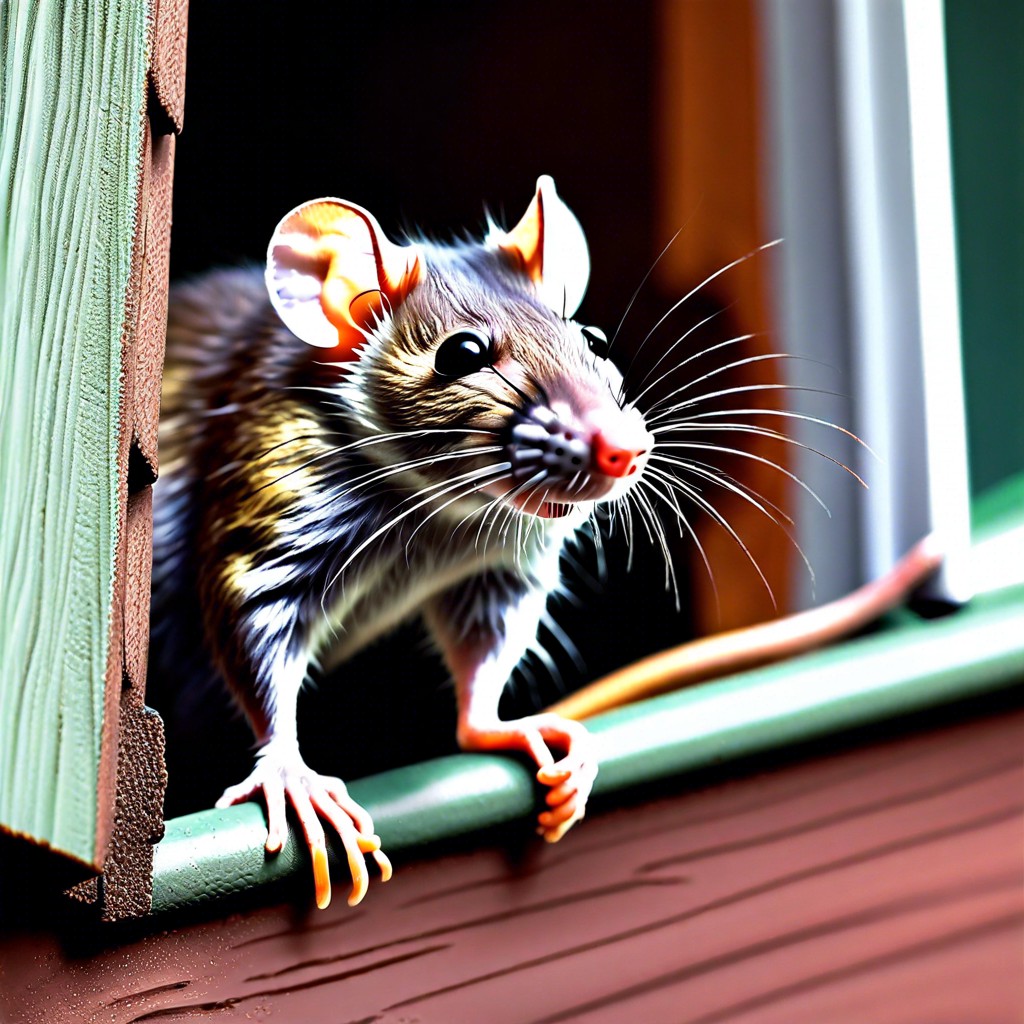Last updated on
This how-to guide delivers comprehensive strategies for effectively ridding your roof of pesky roof rats, covering everything from identifying signs of infestation to implementing various removal and prevention measures.
Key takeaways:
- Roof rats are distinguishable by their sleek fur and long tails.
- Signs of an infestation include scratching sounds, droppings, and gnaw marks.
- Sanitation measures can help deter roof rats from your home.
- Snap traps and live traps are effective in controlling roof rat problems.
- Professional pest control services offer comprehensive solutions for removal.
How to Identify Roof Rats

Roof rats, also known as black rats, are distinguishable by their sleek, black or dark brown fur and long tails which can be longer than their bodies. Adults typically weigh about 5 to 9 ounces and measure about 13 to 18 inches in length, including the tail.
Their pointed noses, large ears, and agile climbing abilities differentiate them from other rodent species, such as the Norway rat.
Roof rats prefer to nest in high places, like attics, rafters, and trees, exhibiting nocturnal behavior that often includes gnawing, scratching, and scuttling noises above ceilings at night.
Droppings, usually spindle-shaped, along with smudge marks or signs of fruit and nut consumption, can indicate their presence.
It is important to address these signs promptly to prevent a full-blown infestation.
Signs of an Infestation of Roof Rats
Hearing scratching or scurrying sounds in the attic, particularly at night, can often be the first indication of these rodents. Sightings of live or dead rats during the day suggest a large population since roof rats are typically nocturnal. Droppings, approximately 0.5 inches long with pointed ends, found along ledges or in commonly traversed areas, are telltale signs. Smears or grease marks along walls indicate high-traffic pathways for these critters. Nesting materials such as shredded paper, fabric, or plant matter located in secluded areas like attics or between walls point towards an infestation. Gnaw marks on food packaging, wood, or electrical wiring further confirm the presence of roof rats. An unusual, pungent odor emanating from hidden areas could signal an infestation, possibly even indicating a deceased rodent within the home.
Sanitation Measures to Deter Roof Rats
Maintaining a clean environment is crucial in deterring roof rats, as it deprives them of the resources they need to survive.
Secure trash in bins with tight-fitting lids, and promptly remove garbage from the property.
Eliminate water sources such as leaky faucets or standing water which can attract these pests.
Keep trees and shrubs trimmed away from the house to reduce access to the roof.
Store pet food and birdseed in sealed containers, and never leave food out overnight.
Regularly clear out storage areas, as clutter provides nesting spots.
By implementing these sanitation practices, you’re creating an unsuitable habitat for roof rats, drastically reducing the chances of an infestation.
Effective Use of Traps for Roof Rats
Selecting the appropriate trap is a pivotal step in controlling a roof rat problem. Snap traps are a conventional choice that can be effective when baited with enticing food like nuts or dried fruit. Position these traps along pathways where roof rats are known to travel, ensuring they are set perpendicular to walls with the trigger section facing the baseboard. This increases the chance of capturing the rodents as they scurry along their usual routes.
For those who prefer a no-kill approach, live traps can peacefully capture roof rats for relocation. Whichever type of trap is used, it’s crucial to wear gloves both when handling the trap and disposing of captured rats. This minimizes the risk of disease transmission.
Glue traps are another option, although they are considered less humane due to the stress and potential injury they cause to the trapped animals.
Strategic placement is equally as important as the type of trap selected. Check and reset the traps regularly, removing captured rats promptly, and re-baiting to maintain effectiveness. Lastly, patience and persistence are key, as it may take time to fully eradicate a roof rat infestation with traps.
Professional Roof Rat Removal Services
When facing a persistent or large-scale roof rat problem, enlisting professional help is a practical option. Pest control experts offer specialized expertise and effective solutions, including:
- Comprehensive Inspections: Professionals conduct thorough inspections to identify all entry points and the extent of the infestation, ensuring no areas are overlooked.
- Customized Treatment Plans: Based on the inspection, experts create tailored strategies that may combine traps, baits, and exclusion techniques for maximum effectiveness.
- Exclusion Techniques: Technicians seal entry points using durable materials, preventing future infestations by making it difficult for new rats to gain access.
- Follow-Up Services: Pest control services typically include follow-up visits to monitor the situation, adjust strategies as needed, and ensure the infestation is completely resolved.
- Safety and Peace of Mind: Professionals use methods that minimize health risks to humans and pets, providing safe and humane removal of roof rats while adhering to local regulations.
By choosing professional pest control services, homeowners can achieve a rat-free roof with the assurance of long-term results and protection.
FAQ
How do you scare rats out of your roof?
To scare rats out of your roof, use items such as peppermint oil, citronella oil, and ammonia as repellents, by soaking a cotton ball in them and placing it near rodent-active areas or creating a homemade spray by diluting them in water.
How do I get rid of rats in my ceiling naturally?
To naturally eliminate rats from your ceiling, utilize natural deterrents such as pepper flakes, onion slices, or garlic cloves around the entrance to your roof void and beneath your furniture, removing the onion slices after a few days to prevent rot.
What causes rats in the roof?
The primary causes of rats in the roof are available entry points, shelter, and sources of food.
What are the most effective rat repellents for roofs?
The most effective rat repellents for roofs include natural deterrents like peppermint oil, predator urine, commercially available ultrasonic repellents, and professional rodent treatments.
How can potential entry points for roof rats be identified and sealed?
Potential entry points for roof rats, like cracks, holes, and gaps in the roof or walls, can be identified by keenly checking the roof’s integrity or employing pest control services and sealed using robust materials like hardwire cloth, metal flashing, or cement.
Are there specific roof materials that deter rats?
Metal roofs are generally known to offer more resistance to rat invasions due to their hard-to-chew surface.





